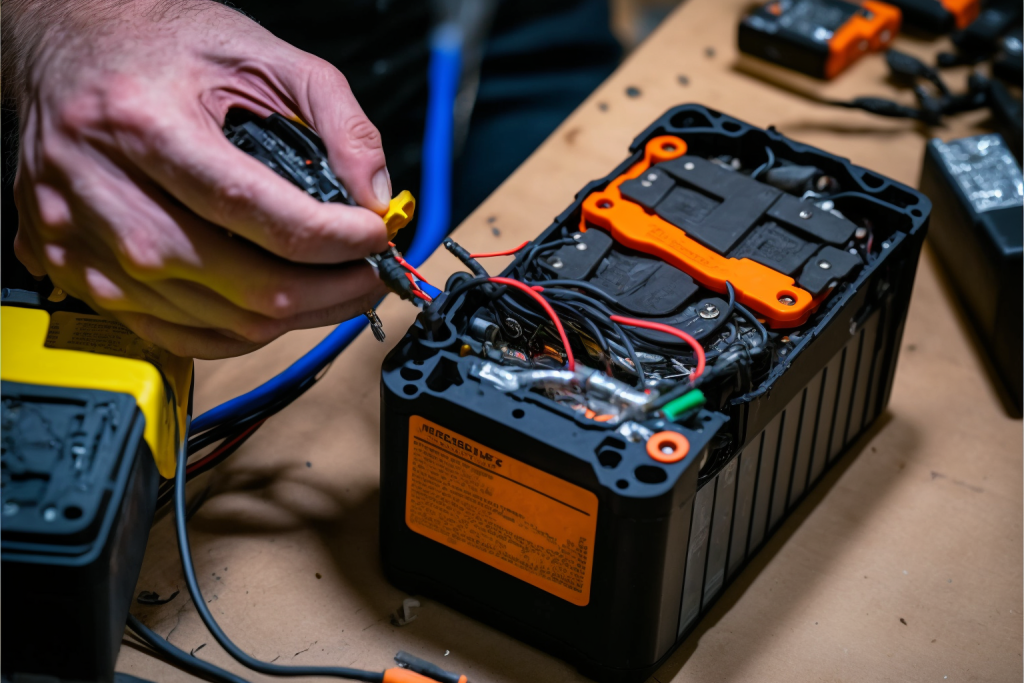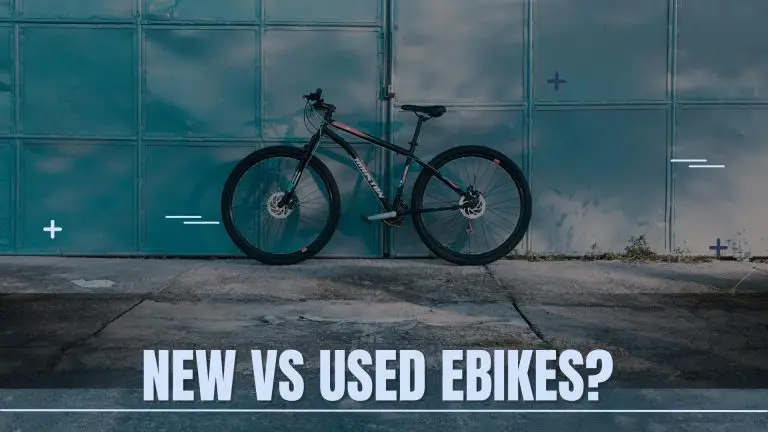Can eBike Batteries be Repaired – Complete Indepth Guide
Contents
I. Introduction
E-bike batteries, also known as electric bike batteries, are the power source that enables an e-bike to function. They are typically lithium-ion batteries, which are known for their high energy density and long life.
How e-bike batteries work An e-bike battery is made up of individual cells that are connected together to provide the desired voltage and capacity. These cells are typically lithium-ion or lead-acid and are encased in a protective housing to prevent damage.
When the e-bike is in use, the battery sends power to the motor through a controller, which regulates the amount of power being sent to the motor. This allows the rider to control the speed and power of the e-bike.
As the e-bike is ridden, the battery is gradually depleted. When the battery reaches a certain level of discharge, it will need to be recharged. This is typically done using a charger that is specifically designed for the e-bike battery.
Types of e-bike batteries
There are several different types of e-bike batteries available, each with its own unique characteristics.
Lead-acid batteries: These are the oldest type of e-bike batteries and are known for their reliability and durability. However, they are also heavy and have a relatively low energy density.
Lithium-ion batteries: These are the most common type of e-bike battery and are known for their high energy density and long life. They are also relatively light and compact.
Lithium-polymer batteries: These are similar to lithium-ion batteries but have a slightly different chemical composition. They are known for their high energy density and long life but can be more expensive.
Nickel-cadmium batteries: These are less common than the other types of e-bike batteries but are known for their reliability and durability.
In summary, e-bike batteries are the power source that enables an e-bike to function and they are typically lithium-ion batteries. They consist of individual cells that are connected together to provide the desired voltage and capacity, and they are encased in protective housing to prevent damage. There are several different types of e-bike batteries available, each with its own unique characteristics.
The purpose of this guide is to provide a comprehensive overview of eBike battery repair and maintenance. It will cover various topics such as whether or not eBike batteries are repairable, the cost of rebuilding an eBike battery, how long an eBike battery can last, and how to fix common issues such as a battery not charging.
Additionally, this guide will also provide tips and tricks on how to bring an eBike battery back to life and extend its lifespan, as well as information on whether eBikes can be ridden without a battery and how to test an eBike battery.
The goal of this guide is to empower eBike owners with the knowledge and tools they need to properly care for and maintain their eBike batteries, ensuring that they continue to function at optimal performance for as long as possible.
II. Are eBike batteries repairable?
E-bike batteries can be repairable, but it depends on the type of battery and the nature of the issue. Some issues with lead-acid batteries can be repaired, while many problems with lithium-ion batteries are best addressed by replacing the entire battery. It is always recommended to consult with a professional or check the warranty before attempting to repair an e-bike battery.
Different types of eBike batteries and their repairability:
- Lead-acid batteries: These are the oldest type of e-bike battery and are considered to be the most repairable. They are relatively simple in design and many issues can be fixed by replacing a damaged cell or component.
- Lithium-ion batteries: These are the most common type of e-bike battery and are considered less repairable compared to lead-acid batteries. While some issues like a faulty cell can be replaced, the majority of problems with lithium-ion batteries are caused by issues with the battery management system or the battery pack as a whole.
- Lithium-polymer batteries: These batteries are similar in repairability to lithium-ion batteries. They are usually less repairable than lead-acid batteries.
- Nickel-cadmium batteries: These batteries are considered to be the least repairable type of e-bike batteries, they are also less common.
Pros and cons of repairing eBike batteries:
Pros:
- Cost-effective: Repairing an e-bike battery can be much more cost-effective than buying a new one, especially if the battery is relatively new and the problem is a simple one that can be easily fixed.
- Sustainability: Repairing an e-bike battery is more sustainable than buying a new one, as it helps to extend the life of the existing battery and reduce waste.
- Convenience: Repairing an e-bike battery can be more convenient than buying a new one, as it avoids the need to purchase and install a new battery.
Cons:
- Complexity: Some e-bike battery issues can be complex and difficult to diagnose and repair.
- Limited repair options: Some types of e-bike batteries, such as lithium-ion batteries, may not be repairable.
- Risk of further damage: Attempting to repair an e-bike battery can also lead to further damage if not done correctly.
- Time-consuming: Repairing an e-bike battery can be time-consuming, especially if the problem is a complex one.
It is important to note that not all e-bike batteries can be repaired and some problems may be best addressed by replacing the entire battery. It is always recommended to consult with a professional or check the warranty before attempting to repair an e-bike battery to ensure that it is safe and cost-effective.
III. How much does it cost to rebuild an eBike battery?
The cost to rebuild an e-bike battery can vary widely depending on several factors such as the type of battery, the nature of the issue, and the location of the repair.
For example, rebuilding a lead-acid battery can cost anywhere from $50 to $100, while rebuilding a lithium-ion battery can cost anywhere from $200 to $500. In some cases, rebuilding a lithium-ion battery may even cost more than buying a new one.
It’s important to note that the cost of rebuilding an e-bike battery may also depend on the location of the repair. The cost of labor and parts can vary widely depending on the region, so it’s important to check with local repair shops for an accurate estimate.
It is always recommended to get a few quotes and compare prices before deciding on a repair shop, this will give you an idea of what to expect in terms of costs. Additionally, you can also check with the battery or bike manufacturer if they have any service centers or if they offer battery rebuilding or replacement services.
IV. How many years will an eBike battery last?
The lifespan of an e-bike battery can vary depending on several factors such as the type of battery, the quality of the battery, usage, and maintenance.
Lead-acid batteries: These batteries can last for about 2-5 years with proper maintenance. Lithium-ion batteries: These batteries can last for about 2-5 years with proper maintenance. With proper use, care and storage, some lithium-ion batteries can last even longer, up to 8-10 years. Nickel-cadmium batteries: These batteries can last for about 3-5 years with proper maintenance.
It’s important to note that the lifespan of an e-bike battery can be affected by several factors such as the frequency of use, the way the battery is stored, and the level of maintenance. To extend the lifespan of an e-bike battery, it is important to:
- Store the battery in a cool, dry place
- Avoid overcharging or undercharging the battery
- Avoid storing the battery in a fully charged or fully discharged state
- Avoid exposing the battery to extreme temperatures
- Use a high-quality charger specifically designed for the battery
To know the expected lifespan of a battery, you can check the manufacturer’s specifications or consult with a professional for an accurate estimate. Additionally, keeping a record of the battery usage, charging and discharging cycles, and regular maintenance will give you an idea of when to expect the battery to start deteriorating and need replacement.
V. How do I fix my eBike battery not charging?
Common reasons why eBike batteries fail to charge:
- Faulty charger: A damaged or malfunctioning charger can prevent an e-bike battery from charging.
- Loose or corroded connections: The connections between the charger, battery and e-bike can become loose or corroded, preventing power from flowing to the battery.
- Battery management system (BMS) issues: Some e-bike batteries have a BMS that regulates the charging and discharging of the battery. If the BMS is malfunctioning, it can prevent the battery from charging.
- Dead or damaged cells: If one or more cells within the battery are dead or damaged, it can prevent the battery from charging.
Troubleshooting and repair steps:
- Check the charger: Make sure the charger is properly connected to the e-bike and that it is functioning properly. Try using a different charger to see if that resolves the issue.
- Check the connections: Make sure that all of the connections between the charger, battery, and e-bike are clean and secure. Use a soft brush and mild cleaning solution to remove any corrosion.
- Check the battery management system (BMS): If your e-bike battery has a BMS, check to see if it is functioning properly. If not, it may need to be replaced.
- Check the cells: If the above steps do not resolve the issue, it may be necessary to check the individual cells within the battery.
It is important to note that some of these issues may require professional repair or replacement of the part, and it is recommended to consult with a professional or the manufacturer before attempting to repair the battery yourself.
VI. How do I bring my eBike battery back to life?
Methods for reviving an eBike battery:
- Equalize the battery: This process involves charging and discharging the battery several times at a lower rate than normal to bring all the cells in the battery back to the same voltage level. This can help to revive a battery that has been stored for a long period of time or has been in a deeply discharged state.
- Calibrate the battery: This process involves running the battery through a full charge and discharge cycle to ensure that the battery management system (BMS) and the charger are properly calibrated. This can help to improve the accuracy of the battery’s remaining charge indicator.
- Store the battery properly: Storing the battery in a cool, dry place, avoiding overcharging or undercharging the battery, and avoiding storing the battery in a fully charged or fully discharged state can help to extend the life of the battery.
Tips for maintaining and preserving an eBike battery:
- Use a high-quality charger specifically designed for the battery
- Avoid exposing the battery to extreme temperatures
- Keep a record of the battery usage, charging and discharging cycles, and regular maintenance.
- Follow the manufacturer’s instructions for charging and discharging the battery
It is important to note that reviving a battery that has been damaged or has reached the end of its life may not be possible, and in such cases, it may be necessary to replace the battery. Additionally, it is recommended to consult with a professional or the manufacturer before attempting to revive an e-bike battery.
VII. Can eBikes be ridden without a battery?
How eBikes function without a battery:
An e-bike, also known as an electric bike, relies on its battery to power the electric motor and assist the rider while pedaling. Without a functioning battery, the e-bike will not have the electric assist and will function as a regular bike.
Pros and cons of riding an eBike without a battery:
Pros:
- Cost-effective: Riding an e-bike without a battery eliminates the need to replace or maintain the battery.
- No need to charge: Without a battery, there’s no need to worry about charging the battery before a ride.
Cons:
- Reduced performance: Without the electric assist, the e-bike will not be able to provide the same level of performance and may be more challenging to ride, especially for longer distances or in hilly terrain.
- Limited range: Without the electric assist, the rider will need to rely solely on their own pedaling power, which can limit the distance they can travel.
It’s important to note that some e-bikes have a freewheel function, which allows the rider to pedal the bike without the assistance of the electric motor, but it is not the same as riding without a battery. Additionally, riding an e-bike without a battery can void the warranty and may not be recommended by the manufacturer.
VIII. How do I test my eBike battery?

Tools and equipment needed for testing an eBike battery:
- A multimeter: This tool is used to measure the voltage and resistance of the battery and its cells.
- A load tester: This tool is used to measure the capacity of the battery by applying a load to the battery and measuring the voltage drop.
- Battery analyzer: This tool is used to analyze the battery’s health, state of charge, and overall performance.
Step-by-step guide for testing an eBike battery:
- Disconnect the battery from the e-bike: Before testing the battery, it should be disconnected from the e-bike to ensure accurate results.
- Measure the voltage: Use a multimeter to measure the voltage of the battery. The voltage should be within the range specified by the manufacturer.
- Measure the resistance: Use a multimeter to measure the resistance of the battery. The resistance should be within the range specified by the manufacturer.
- Test the capacity: Use a load tester to apply a load to the battery and measure the voltage drop. The capacity of the battery should be within the range specified by the manufacturer.
- Analyze the battery: Use a battery analyzer to analyze the battery’s health, state of charge, and overall performance.
It’s important to note that these steps may vary depending on the type of battery, and it is always recommended to consult with a professional or manufacturer for specific instructions on how to test your e-bike battery. Additionally, it is also recommended to keep a record of the test results and compare them over time to have an idea of the battery performance over time.
IX. Conclusion
E-bike batteries play a crucial role in the functioning of an e-bike. Proper maintenance and repair of these batteries can ensure optimal performance and prolong their lifespan. This guide has provided a comprehensive overview of e-bike battery repair and maintenance, covering various topics such as repairability, cost, lifespan, and common issues. It is important to consult with a professional or manufacturer before attempting to repair or revive an e-bike battery. Proper usage, care and maintenance can help extend the life of the battery and ensure safe and enjoyable e-biking experience.






